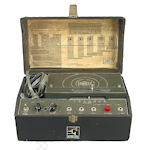
In the late 1950s, a groundbreaking invention emerged in the world of music— the Maestro Echoplex. Conceived by Mike Battle and released by the Maestro company in 1959, this tape delay effect unit swiftly became a trailblazer in shaping the sonic landscape.
Operating on tape delay technology, the Echoplex utilized a loop of magnetic tape to craft mesmerizing echo effects. Its mechanism involved recording the signal onto the tape and playing it back after a brief delay, resulting in a warm and distinctive sound. This innovation quickly found favor among musicians, particularly guitarists seeking to experiment with novel delay effects.
Throughout the 1960s and 1970s, the Echoplex soared in popularity, finding a home in the rigs of iconic artists like Jimmy Page, David Gilmour, Brian May, Tommy Bolin and Eddie Van Halen. Its analog charm and user-friendly controls made it a go-to choice for those exploring creative soundscapes.
An example of its use beyond echo and delay can be heard in the guitar solo in Grand Funk Railroad's "The Locomotion". Guitarist Mark Farner moves the delay setting slider during the performance to create a unique effect. (Solo begins at 1:12.)
Early vacuum tube-powered models were coveted for use as pre-amps, with the echo and delay effect being little-used.
The Echoplex's journey included the release of various models, with the EP-2 and EP-3 earning special acclaim for their sound quality and reliability. However, as with many tape-based effects, challenges arose with maintenance, and the advent of digital delay units in the 1980s led to the discontinuation of the original Echoplex models.
Despite its decline, the Maestro Echoplex left an enduring legacy. Its warm, analog tones influenced subsequent generations of musicians, and the unit remains a sought-after vintage piece. Modern iterations and emulations seek to capture the magic of the Echoplex, ensuring its impact continues to resonate in contemporary music.
The Maestro Echoplex, with its rich history and distinctive sound, stands as a testament to the ever-evolving tapestry of musical innovation.
